|
|
|
|
|
|
Claudia Villela: This singer with a five-octave range—called "the biggest expression of Brazilian music in the U. S."—will draw you into her haunting improvisations and playful singing. Hear audioclip...
|
Moscow Festival Ballet presents Cinderella. Leading dancers from across Russia, including those from Bolshoi and Kirov ballets, will whisk a lonely girl from the clutches of her evil stepmother and into the arms of a handsome prince in this charming storybook ballet danced to Prokofiev's score. View videoclip... |
The Great Tennessee Monkey Trial. Debates continue today over the separation of Church and State more than eighty years after the Scopes Trial was held in a small-town Tennessee courtroom. The characters at the center of that famous national conflict of social and intellectual values come to life in this magnificent production, starring Golden Globe Award-winner Ed Asner. Hear audioclip... |
46th Annual Philadelphia Antiques Show
April 14-17
Special Loan Exhibit:
“Philadelphia Empire Furniture: Bold, Brash & Beautiful”
www.philaantiques.com
|
|
|
|
Desk and Bookcase Carved and Veneered Mahogany Philadelphia, Circa 1820-1830 Private Collection
The upper columns have Corinthian capitals and the lower columns are modified Ionic. A "paneled out" construction in the manner of ancient Etruscan decorated walls adorns the front surface of the fall front desk and cabinet doors. The door muntins arch at the top with an angle that corresponds to that of the acanthus decorated corner acroterion. Between these, the triangular central pediment is veneered mahogany. The overall effect is directly derived from pediments frequently seen surmounting Greek temples and other monuments. All glass knobs are original. Photo from the book Philadelphia Empire Furniture, The Boor Family. |
French Secretary, mahogany; Strong Attribution to Anthony Quervelle Philadelphia, Circa 1825-1830 Private Collection
This "French secretary" or secretary a abattant is almost certainly the work of Quervelle's shop. The detail and moldings above the interior drawer spaces are identical to those of a desk design of Quervelle. Some features of the piece can also be related to Quervelle's, including the use of veneered stained burl maple columns, the use of a semicircular panel in the upper rectangular element of the pediment of the secretary, and the use of gilt stenciling, which is often seen on Quervelle's pier and center tables. The general construction of this piece is a rectangular box base with a sloping, cone shaped section above which appears to be distinctive to a small number of Philadelphia made fall-front secretaries of this period. Photo from the book Philadelphia Empire Furniture, The Boor Family. |
Penn Museum 25th Annual Maya Weekend:
April 13-15
|
|
|
25th Annual Maya Weekend: The Dawn of Mayan Civilization; explore Mayan Kingdoms through scholars, films, and workshops; 10 a.m.; Penn Museum; weekend: $175, $140/members; Maya banquet extra; info.: www.museum.upenn.edu/new/mayaweekendregistration.shtml. Through April 15 (Museum). Pictured above: artwork derived from pre-classic murals at San Bartolo painted by Heather Hurst for the Proyecto San Bartolo. |
|
|
|
Engraving Pyramid Tomb of Caius Cestius {From the Le Vedute di Roma (The Views of Rome), 1748-78} from the exhibit, Piranesi: The Grandeur of Ancient Rome. Sixty works by Giovanni Battista Piranesi, one of the major artists of 18th century Italian etching, are featured in this exhibition. Born in Venice and educated to be an architect, Piranesi spent most of his life in Rome, becoming an authority on Roman archaeology. Architectural remains of ancient Rome were a major source of inspiration to Piranesi, whose goal— was realized in numerous, often large-scale etchings of famous ancient sites. A superb technician, Piranesi combined a mastery of draftsmanship and perspective, a strong knowledge and love of Roman antiquities, a sense of drama and an epic imagination in his etchings. This traveling exhibition, coordinated by Blair-Murrah, includes engravings of Hadrian’s Villa in Tivoli, the ancient Roman Forum and the Pyramid Tomb of Caius Cestius, as well as many tombs, ancient amphitheaters, bridges, fountains and temples. Through June 16. |
Tapirapé: A wax figurine, Topu, representing the messenger of Kanawana, a supernatural spirit. Photo © Houston Museum of Natural Science from the exhibit, Vanishing Worlds: Art and Ritual of Amazonia. Prior to European contact beginning in the 1500s, between 3 and 5 million people thrived in the Amazon river basin region of South America, an ecologically diverse land mass of 2.5 million square miles. Today, fewer than 100,000 Amazonian native people survive, and the vast majority of people who once occupied the Amazon have disappeared forever. This exhibition features over 150 ritual objects from the Ka'apor, Karaja, Tapirape, Ticuna, Shipibo-Conibo, and Shuar, several Kayapo peoples, and Xingu River region peoples. Colorful headdresses, masks, body ornaments, and full body costumes, as well as domestic and utilitarian pieces like basketry, weapons, pottery and textiles, are showcased. Second floor Dietrich Gallery. Through June 30. |
International House Exhibits
|
|
 |
|
La Flor De La Noche Buenos Aires, Argentina from the exhibit Argentine Adventures, A collection of work from Argentina focussing on the two main regions of Argentina: Buenos Aires and Patagonia, by photographer Patrick Esmonde. The exhibit will run April 16 through May 18. |
Love, Loss and Longing: The Impact of US Travel Policies on Cuban-American Families: Photo exhibit which shows the cruel human impact of the Bush Administration’s rules impeding contact between Cuban-Americans and their loved ones in Cuba. The photos represent 20 Cuban-Americans, from different walks of life, who can no longer visit their families in the island. Through April 9. |
Artbots
Esther Klein Gallery
April 13-June 30 |
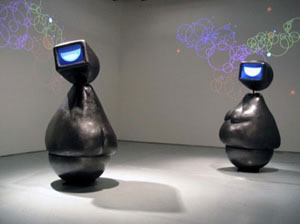 |
| Started in 2002 by Douglas Repetto, Artbots is an international art exhibition that features robotic art and art-making robots. This exhibition will bring 7 works to the gallery and pair local scientists and artists with Philadelphia public school children to create their own original works of robotic art and to participate in educational workshops. |
Faces and Abstractions: Photography by Max Buten
Burrison Gallery
Through April 27 |
Zero Point Axis
Slought Foundation
April 5 through June 1
|
|
Exhibition by artist George Quasha featuring "axial stones," paired stones configured through the artist's acts of precarious balance (without alteration of stones or the addition of fixing agents).
|
The Truth in Photography: The Work of Hervé Guibert
Slought Foundation
April 20 through June 1
|
|
“Photographs are not innocent. They influence and ... betray what is hidden beneath the skin. They weave not only lines and grids, but plots, and they cast spells.... They are an impressionable material that welcomes spirits.” -- Hervé Guibert, Ghost Image
|
The Art of Reinvention: Travel — Exile — Recuperation
Rosenwald Gallery, Van Pelt-Dietrich Library
Through April 13
|
|
Presented in collaboration with the Penn Humanities Forum, this exhibition explores the tales of two artists whose political exile occurred fifty years apart. The Prague-born writer Franz Werfel became expatriated with the annexation of Austria by Germany in 1938. He and his wife, Alma Mahler, eventually settled in California and remained at the center of a vibrant émigré community of European artists, musicians, and writers. The exile of conceptual artist Kinga Araya from communist Poland in 1988 informs her work, which includes performance art, photography, sculpture, video, drawing, and writing. Their stories are juxtaposed through the display of artifacts and creative pieces that interrogate notions of identity and homeland.
|
Dissolution of Prepublic Image
Annenberg Center
Through April
|
|
Kanishka Raja's painting Dissolution of the Prepublic (Version 2) builds an improbable architectonic world by suturing together domestic interiors with stark airport terminals, urban vistas and runways in environments redolent of memory and mobility. Someone, though we cannot say for certain who, is simultaneously at home and in transit. Raja's psycho-geographic spaces set up a narrative tension but are devoid of specific subjects. By leaving the viewer to identify with the space of the painting one can project any number of imaginative narratives into it.
|
Equus Unbound: Fairman Rogers and the Age of the Horse
Kamin Gallery, 1st floor, Van Pelt-Dietrich Library
March 1 through June 15
|
Amarna, Ancient Egypt's Place in the Sun
Penn Museum
Through October
|
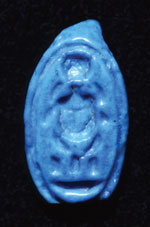 |
 |
|
Ring bezel, Amarna, Dynasty 18, reign of Akhenaten (1353-1336 BCE), faience. Ring bezel decorated with the cartouche of Tutankhamun. Photo courtesy of Penn Museum.
|
The city of Amarna was bordered on its eastern side by cliffs of uniform height. Almost at midpoint of the city, the cliffs are interrupted by a gap (the Wadi Abu Hasan el Bahri). Viewed from afar, this break in the cliffs creates a large natural silhouette of the hieroglyph for "horizon" (akhet). Akhenaten may have chosen this site for his new capital city dedicated to his god, the disk of the sun, the Aten, because this natural rock formation created the "Horizon of the Aten" or, as it was known by its ancient Egyptian name, Akhet-aten. This view is taken from the south. Photo by David Silverman.
|
Statue of an Amarna Princess, probably from Amarna, Dynasty 18, reign of Akhenaten (1353-1336 BCE), limestone and pigment. Amarna art placed considerable emphasis on the six daughters of Akhenaten and Nefertiti: Meritaten, Meketaten, Ankhesenpaaten, Nefernefruaten Tasherit, Nefernefrure and Setepenre. The identity of this princess is not known. Photo courtesy of Penn Museum.
|
ICA Exhibits
April 20 through August 5 |
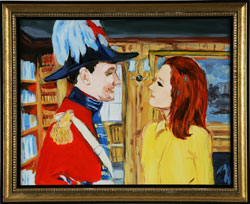 |

|
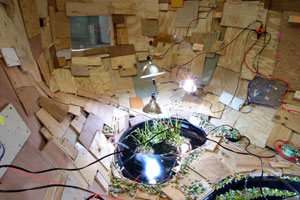 |
From the exhibit by Karen Kilimnik, Steed leaving for costume party on deserted island - emma stays home to work; 2006 Water soluble oil color on canvas 11 x 14 inches Courtesy 303 Gallery, New York. |
From the exhibit, Crimes of Omission, Geraint Evans Dumpster (detail), 1998 Acrylic on board friezes 17 1/4 x 31 inches each Set of 7. Courtesy of the West Collection, SEI. |
From Phoebe Washburn's ramp exhibit, Minor In-House Brain Storm, 2006-07 Installation view, Whitney Museum of American Art at Altria, Courtesy: Zach Feuer Gallery, New York Photograph: George Hirose. |
Arthur Ross Gallery
Through May 6
|
|
Dramatic Impressions: Japanese Theater Prints from the Gilbert Luber Collection. Exhibition of works produced between 1916-1929 of Shunsen (1886-1960), a brilliant designer of woodblock. By focusing on representations of theater and actors, early modern printmakers developed a vocabulary of visual forms recreating the effects of staging, pose, make-up, and costume. |
 |
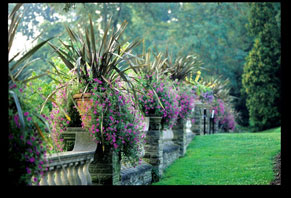 |
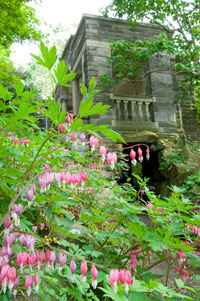 |
| Great Gardens of the Philadelphia Region: An inspired photographic tour of the Delaware Valley's rich and diverse horticultural legacy as seen through the lens of renowned photographer Rob Cardillo. From the majestic estates of Delaware, to the vital community gardens of center city, this exhibit reveals why Philadelphia and its surrounding towns, suburbs and countryside are considered the horticultural epicenter of the United States. Above left: Balustrade surrounding the iconic Rose Garden at the Morris Arboretum; Above right: View to the Mercury Loggia at the Morris Arboretum. Bleeding heart (Dicentra spectabilis) in foreground |
meta Metasequoia
Morris Arboretum
Ongoing |
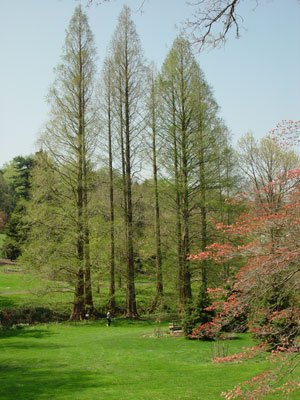 |
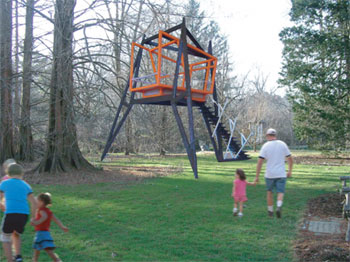 |
| Nestled within the dawn redwood grove, meta Metasequoia will provide a fresh perspective of these wonderful trees. The exhibit will elevate visitors up into the tree canopy of the dawn redwoods by means of an artistic structure with stairs leading to the "basket," an open-air room whose floor is 12 feet above grade. Climbing up into the structure, nicknamed the "Grasshopper," visitors will be able to revist the childhood feeling of being in a tree house, enjoy the views and relax in unusual intimacy with these majestic trees. |
Coming to the Small Screen: Ormandy & Television
Eugene Ormandy Gallery, Van Pelt-Dietrich Library
Ongoing |
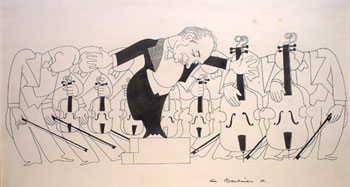 |
| Drawing by Alfred Bendiner, ca. 1952.
Eugene Ormandy dedicated his life to music, from the age of three, when he first picked up a violin, to shortly after his 84th birthday, when he conducted his last concert with the Philadelphia Orchestra. It is with this orchestra that Ormandy's name will forever be associated, by virtue of his serving as its Music Director for 42 years. Image courtesy of the University of Pennsylvania Architectural Archives. |
A Wonderful Life: A Daughter's Tribute to a Family of Educators
Lobby, GSE
Ongoing |
|
Pennsylvania Daughter by Joan Myerson.
Digital "painting" of the artist's mother as Penn student.
|
|
Almanac -
March 27, 2007, Volume 53, No. 27
|
|
|